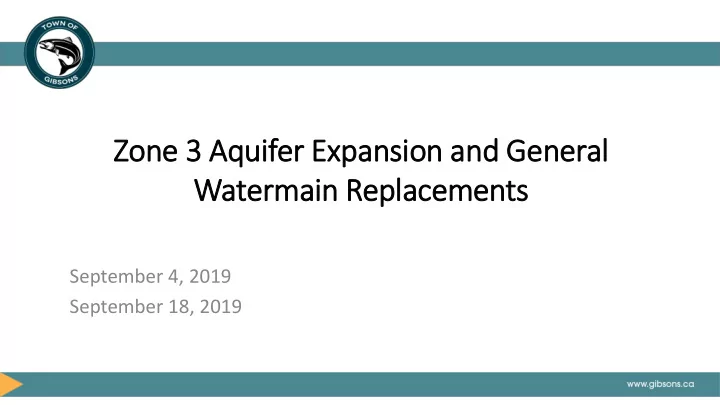

Zone 3 Aquifer Expansion and General Watermain Replacements September 4, 2019 September 18, 2019
Overview 1. Alternative Approval Process (AAP) 2. Water System Overview 3. Aquifer Capacity Overview 4. Schedule
AAP Scope
Financing Details • 25 Year Term • Debt payments estimated at $182,000/year • Debt payments offset by bulk water savings • Future Development Cost Charges (DCCs) could also be used to offset principle
Financial Impact of Expansion • Comparison of two options (Status Quo vs expansion): • Over life of assets, overall costs of expansion significantly lower than status quo • Comparison includes capital, operations, and maintenance
Wells 5 and 6 • Average Daily Demand ~7200 pop. Wells 1, 3, 4, 6 Assume one well out of service (redundancy • Maximum Daily Demand ~6000 pop. for maintenance)
System Overview – Three Zones, Two Sources Th Three zones • Zones 1 and 2 - Gibsons Aquifer Z3 • Zone 3 - SCRD water • Allows appropriate pressure Z2 Two So Sources Z1 • Lack of infrastructure • Prior to 2015, inadequate aquifer capacity…
How does the Town’s water system operate? Parkland Reservoir – Fire flow, School Rd MDD, PHD Reservoir – Fire flow, Water pumped from MDD, PHD School to Parkland Water flows from 6 4 reservoir to Zone 1 7 1 Supply wells 5 3 Water flows from Water pumped from wells reservoir to Zone 2 to School Rd
Zone 3 supply - Now SCRD supply Zone 3 Zone 2 Valves between Zones - automatically open in the event of fire Zone 1
Zone 3 supply with new pump station SCRD – Peak Hour, Emergency Storage, Fire Flow Watermain Pumphouse and chlorinator – Zone 3 ADD & MDD Zone 2 Valves between Zones - automatically open in the event of fire Zone 1
Managing our Natural Asset: Aquifer Capacity 1. What assets do you own? (inventory) 2. What is the asset worth? 3. What is the asset condition? 4. Establish your operations and management plan 5. Establish your financial plan 6. Assess the ability of the asset to increased demand 7. Ongoing assessment
“Climate change/variability and the effects on aquifer recharge are somewhat uncertain and can only be quantified by long-term monitoring trends and assessing cause and effect response in the aquifer.” Aquifer Mapping Study, p. 86 “In addition to monitoring the existing well network, additional wells will likely need to be installed in advance of significant land development in order to understand the cumulative effects that the proposed development will have on the aquifer.” Aquifer Mapping Study, p. 91
Annual Groundwater Monitoring • Annual program since 2009 • Eight Town monitoring wells • Includes new wells to monitor pressure and salt water intrusion • Four production wells • Some private wells monitored
Aquifer Capacity & Climate Change • Modeled capacity of Aquifer • 1.66 million cubic metres/year • Assumptions: • 15% reduction in overall recharge • 50% reduction in snow pack • 1 metre rise in sea level
Aquifer Capacity & Climate Change “In summary, the Gibsons Aquifer should be able to supply the Town’s water supply needs [7300 pop] even under moderate to extreme climate change predictions. If long-term groundwater monitoring data indicates that threshold limits are being approached, then there may be a need to abandon existing supply wells located near the coast and replace them with wells located further from the coast.” Aquifer Mapping Study, p. 89
Aquifer Capacity and Water Metering Town initiates Litres per capita per 2018 universal metering day - includes residential, Aquifer Mapping • Metered supply: commercial, leaks projections • ~ 370 lcd Physical separation from Zone 3 • Metered residential: • < 200 lcd
Zone 3 Service Area Expansion • Modeled capacity of Aquifer • 1.66 million cubic metres/year • Projected Use (2011 calculation) • 570 l/c/d /1000 x 7,300 persons x 365 days = 1.52 million m3/year (Buildout Zones 1 & 2) • Projected Use (2018 calculation) • 400 l/c/d /1000 x 10,000 persons x 365 days = 1.46 million m3/year (Buildout Zones 1, 2 & 3)
Proposed Gibsons Aquifer Water Use and Capacity 2000 Aquifer capacity Total Water Volume (cubic meters x 1000) 1600 1200 Aquifer capacity Z3 License Amended licence 800 Exg well use Z1 & Z2 License Z1 & Z2 800 lcd (2008) 400 Z1 & Z2 573 lcd (2011) Z1, Z2, Z3 400 lcd 0 0 4600 4880 5390 5950 6570 7250 8010 8840 9760 10000 10000 10000 Population: 2017 2020 2025 2030 2035 2040 2045 2050 2055 2060 2065 2070 Year:
Town Stewardship of the Aquifer Watershed: ✓ Completed 2009-2013 Aquifer study ✓ Well inspections ✓ Mapped extents ✓ Monitoring well network ✓ Determined recharge area ✓ Long-term monitoring Program ✓ Aquifer capacity = Town buildout ✓ Enhanced Sampling Program ✓ Asset Management Policy includes Natural Assets ✓ Universal Metering Program ✓ DPA9 (aquifer protection) ✓ Cross Connection Control (CCC) Program ✓ Water regulation bylaw updates ✓ Proposes Town/SCRD Groundwater Mgmt Zone ✓ Zoning bylaw – no drilling permitted ✓ Opened discussions with FLNRO re logging practices ✓ DCC Bylaw – includes cost of using natural assets
Ministry of Forests, Lands, Natural Resource Operations & Rural Development: “We are very impressed by the effort and approach that the Town is taking to protect the Gibson Aquifer and plan for a sustainable future. It is evident that the Town is very forward-thinking, and truly values the water resource.”
Timeline: • Aug 26 to Sept 25 2019 – AAP response period • Oct 2019 – Tender award (assuming successful AAP) • Nov 2019 to May 2020 – Pump station construction • Mar 2020 to May 2020 – Watermain construction • 2021 – Commission Well 6 • 2022 (?) – Consider commissioning Well 5 • 2049 (+/-) – Drill and commission Well 7
Recommend
More recommend